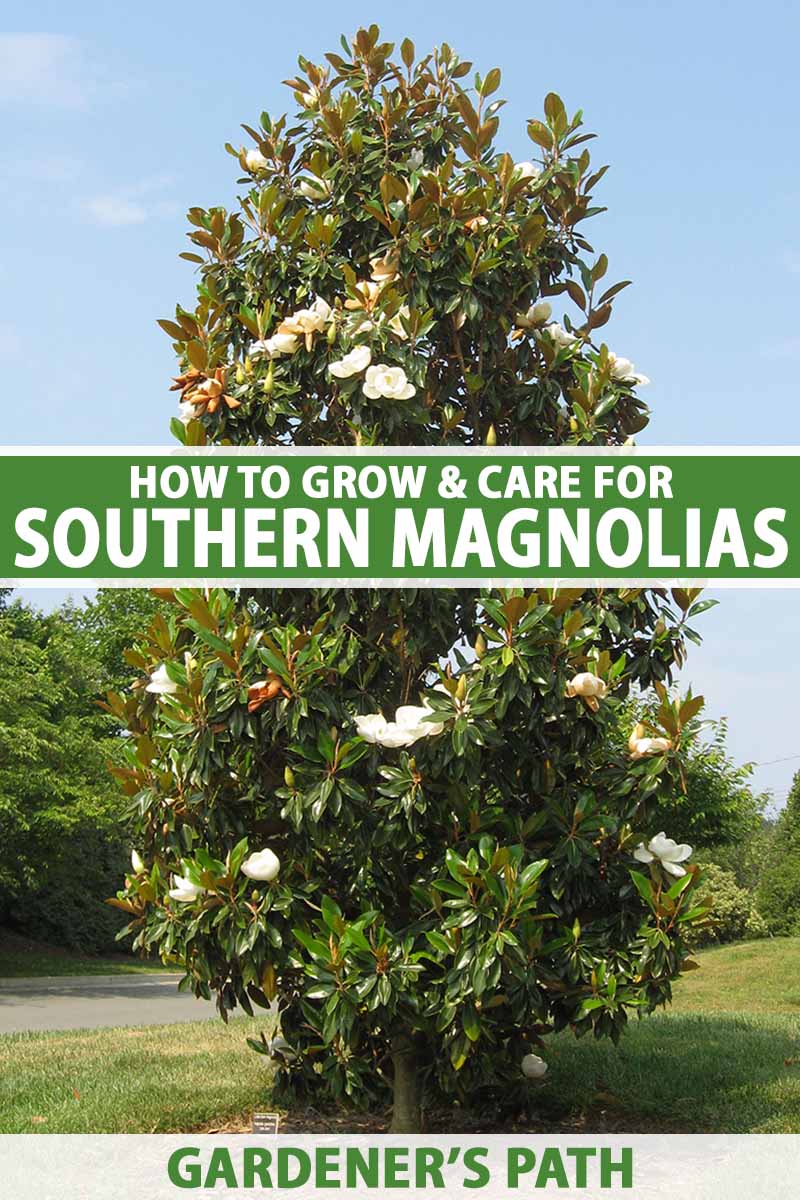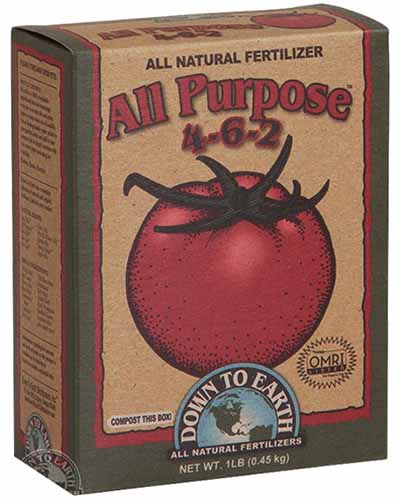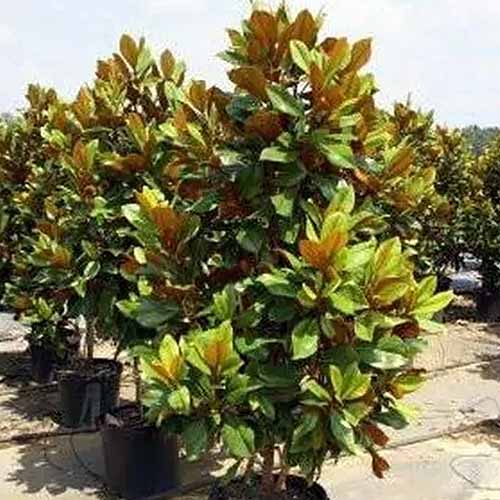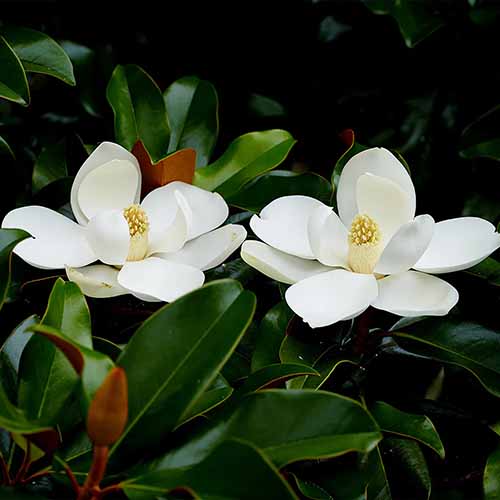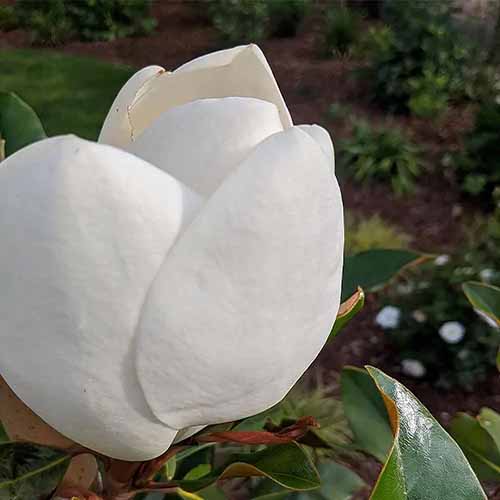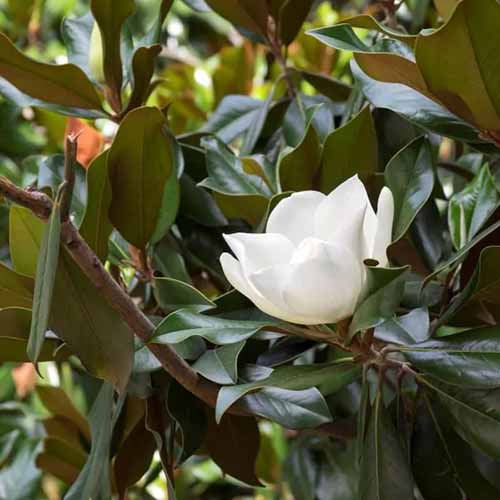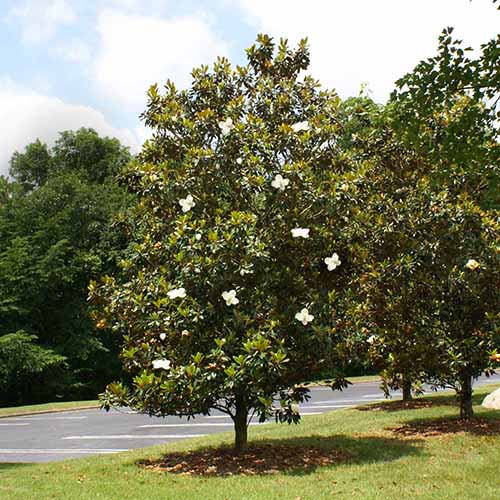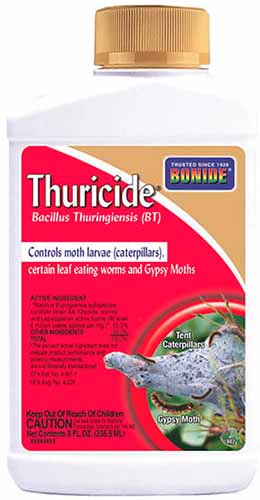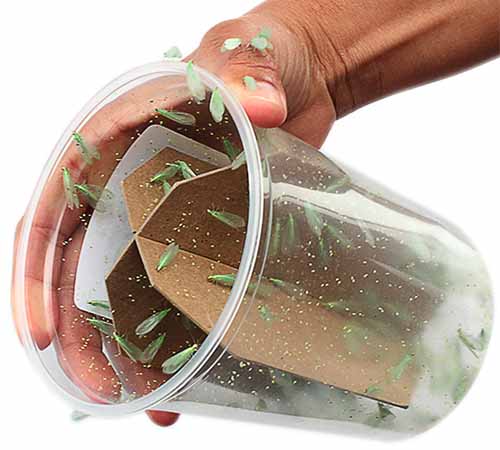Magnolia grandiflora
Some trees are grand and others have striking floral displays, but only a handful, like the southern magnolia, can do both.
Southern magnolias produce huge, striking flowers, and not just a few of them, but an abundance! The blooms appear in the spring and sometimes again in the summer.
Plus, these magnolias are evergreen, which means you don’t have to stare at bare branches during the winter.
On top of that, southern magnolias are generally pest- and disease-free, grow to majestic heights – though you can find shorter cultivars – and they don’t need much maintenance to maintain all this grandeur.

We link to vendors to help you find relevant products. If you buy from one of our links, we may earn a commission.
The southern magnolia is the state tree of Mississippi, sometimes called the bull-bay, big-laurel, large-flower, or evergreen magnolia, and can be cultivated in USDA Hardiness Zones 6 to 10.
As some of the common names indicate, the leaves look somewhat laurel-like, but they’re much, much larger and often have attractive bronze-colored undersides.
You’re probably already familiar with this North American native if you live in the South, but the trees can grow in a variety of climates outside of their native range.
They’re even popular in locations with completely different climates to the humid heat of the south, like England and the Pacific Northwest.
I have a tulip poplar that I’m itching to tear out, and when I do, a southern magnolia is going in its place.
I can’t wait to enjoy the year-round color and giant, waxy, fragrant flowers. Until then, I’ll continue to marvel at the many specimens growing in my neighborhood.
Do you fancy one of your own, too? We’re going to help make that happen by discussing the following:
What You’ll Learn
Cultivation and History
The southern magnolia is classified in the Magnolia genus, which comprises about 240 species.
It’s native to North America, where it grows in the southeastern United States of Alabama, Florida, Georgia, Louisiana, Mississippi, North Carolina, and Texas.
It favors coastal plains, upland, and lowland areas, and doesn’t grow above 500 feet in elevation in the wild, but is seen in cultivation at higher altitudes.
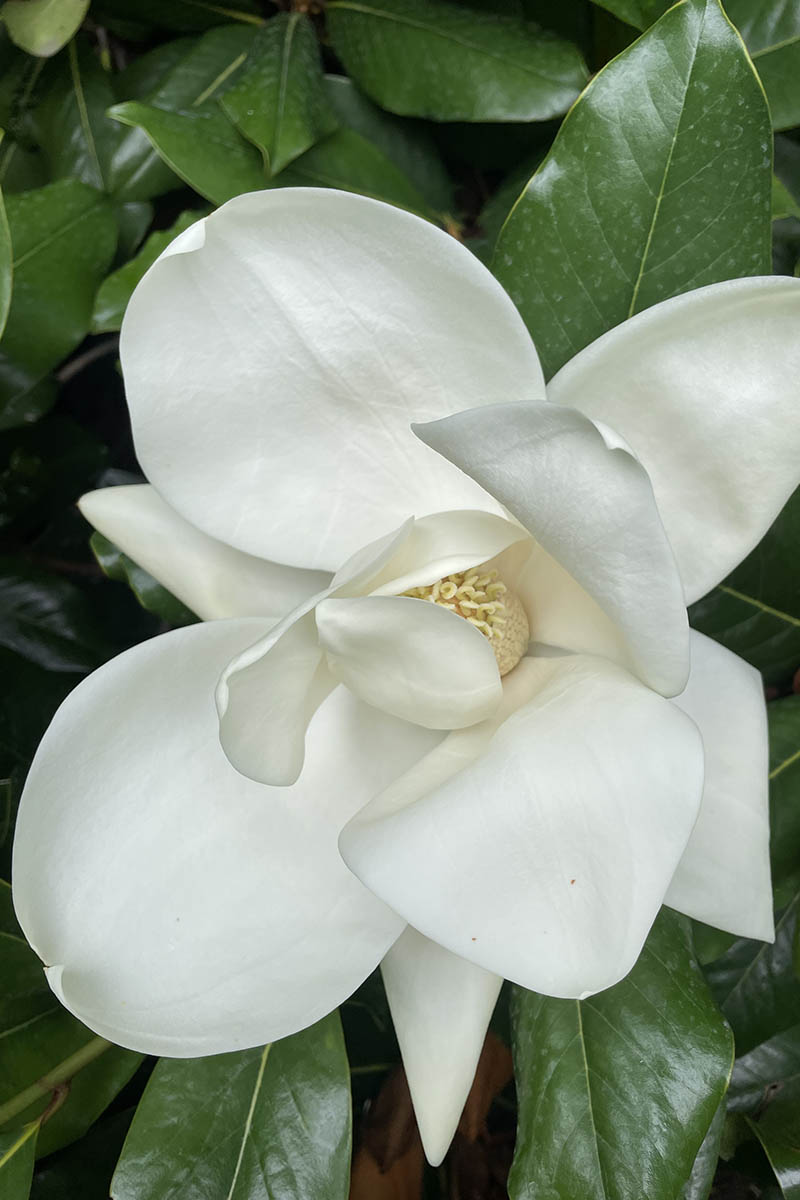
It grows in areas that receive at least 40 to 80 inches of rain per year with temperatures between 15 and 90°F, in warm temperate or semi-tropical climates.
This species generally grows to about 80 feet tall, though some specimens have achieved much greater heights.
There are a few in Florida measuring over 125 feet tall. In cooler climates, they tend to stay much shorter.
Southern magnolias tend to be moderately fast growing, adding up to 18 inches of height each year, and require up to 50 years to reach their mature height.
They will start fruiting and flowering much sooner, producing flowers when they are just three years old and typically fruits appear when they are 10 years old. The trees can live up to 120 years.

Most have a pyramidal growth habit, but there are some cultivars with oval, round, or columnar shapes. The bark is smooth and gray, though older specimens take on a scaly texture.
The simple, alternate leaves are elliptic or oval shaped with solid (entire) margins.
The leaves are typically medium green and glossy on top, and brown or rust-colored and matte with a faint fuzz underneath. They can reach up to eight inches long. The foliage doesn’t change in the fall. Remember, this is an evergreen.
And then there are the flowers. The huge, showy, saucer-shaped blossoms can be up to 14 inches across and are creamy-white with a waxy coating and an intense lemon fragrance. When they’re blooming, the whole yard will be perfumed.
These blossoms appear in the spring and may sometimes reappear in the summer in smaller numbers.
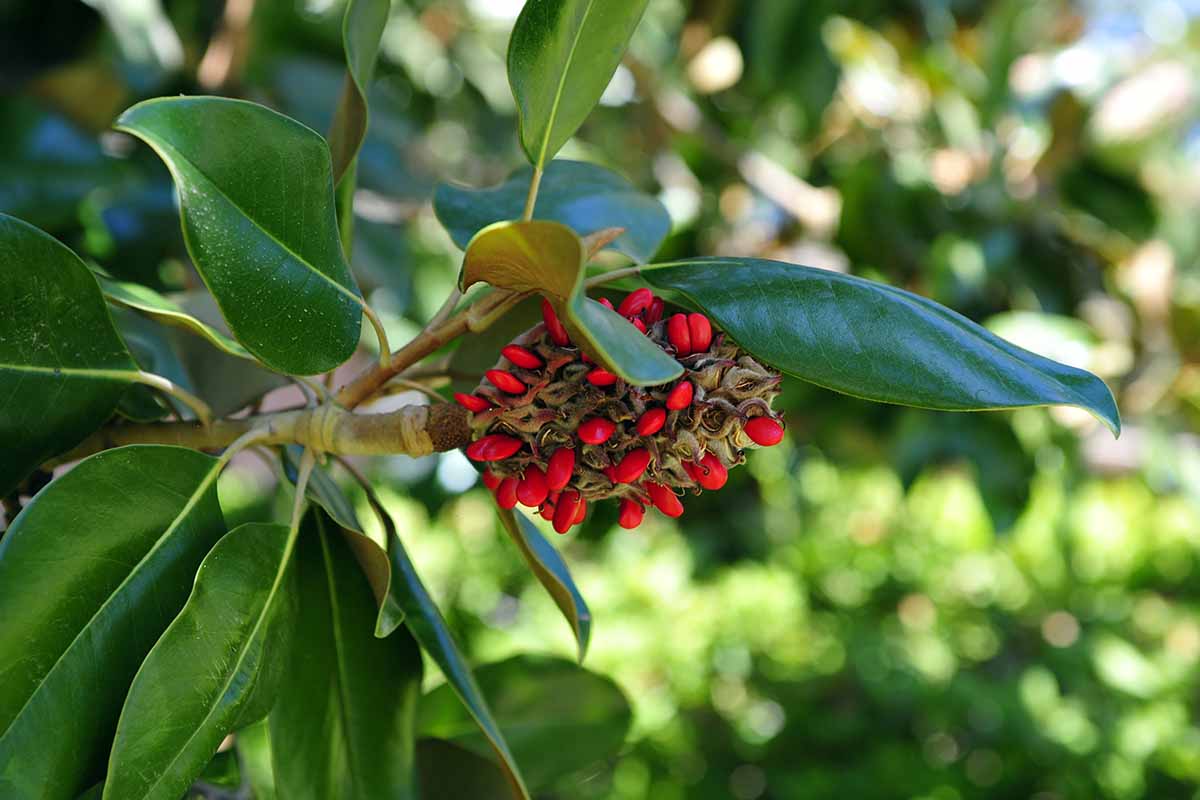
After the flowers fade, small fuzzy brown fruit cones develop.
At maturity they are about five inches long and covered in bright red drupes, which the birds love. So do squirrels and other herbivores, especially when they fall to the ground.
Southern magnolias are cultivated around the globe and are popular in the UK, where they were introduced in the early 1730s.
It’s often confused with the sweetbay magnolia (M. virginiana), but sweetbays are smaller in every way, from the leaves and flowers to the height and trunk circumference.
Southern Magnolia Propagation
Southern magnolias are one of the easiest species in the genus to propagate.
These trees can be grown from seed. However, the resulting tree could be very different from the parent in terms of size, shape, growth rate, and flowering, unless you’ve managed to secure seeds from a species tree and not a cultivar.
If growing magnolia from seed is something you’re interested in, our guide has all the details. M. grandiflora is extremely easy to propagate by seed, so it’s an excellent option if you’re considering this method.
From Cuttings
Unlike starting from seed, propagation via cuttings will give you an exact clone of the parent plant.
Wait until the spring, when new growth has started developing at the end of the stems, and take an eight-inch cutting using clean, sharp trimmers. Make the cut at a 45-degree angle.
Remove all of the leaves except for the top two. Cut these in half vertically to reduce the amount of tissue the cutting has to support.
Fill a gallon-sized container with seed starting medium and poke a hole in the center.
Dip the end of the cutting in powdered rooting hormone and set the cutting into the hole you made. The cutting should be about two inches deep.
Soak the medium so it feels moist but not soaking wet, like a well-wrung-out sponge, and place the pot outdoors in an area with dappled or partial sunlight.
Keep the soil moist as the cutting develops roots, which can take a month or more. Eventually, you’ll start to see new foliar growth develop.
So long as the weather isn’t too hot and dry, when you see the new growth you can put the plant in the ground. However, I’d recommend keeping the plant in the container until the following spring or the following fall.
It’s best to transplant before the new specimen reaches four feet tall. A height between two and four feet is ideal.
Transplanting
It’s best to transplant southern magnolia saplings in the spring rather than the fall. Many trees do well when planted in the fall, but magnolias, in general, do better in the spring.
That said, if fall works better for you, they’ll probably be just fine. Southern magnolias are adaptable.
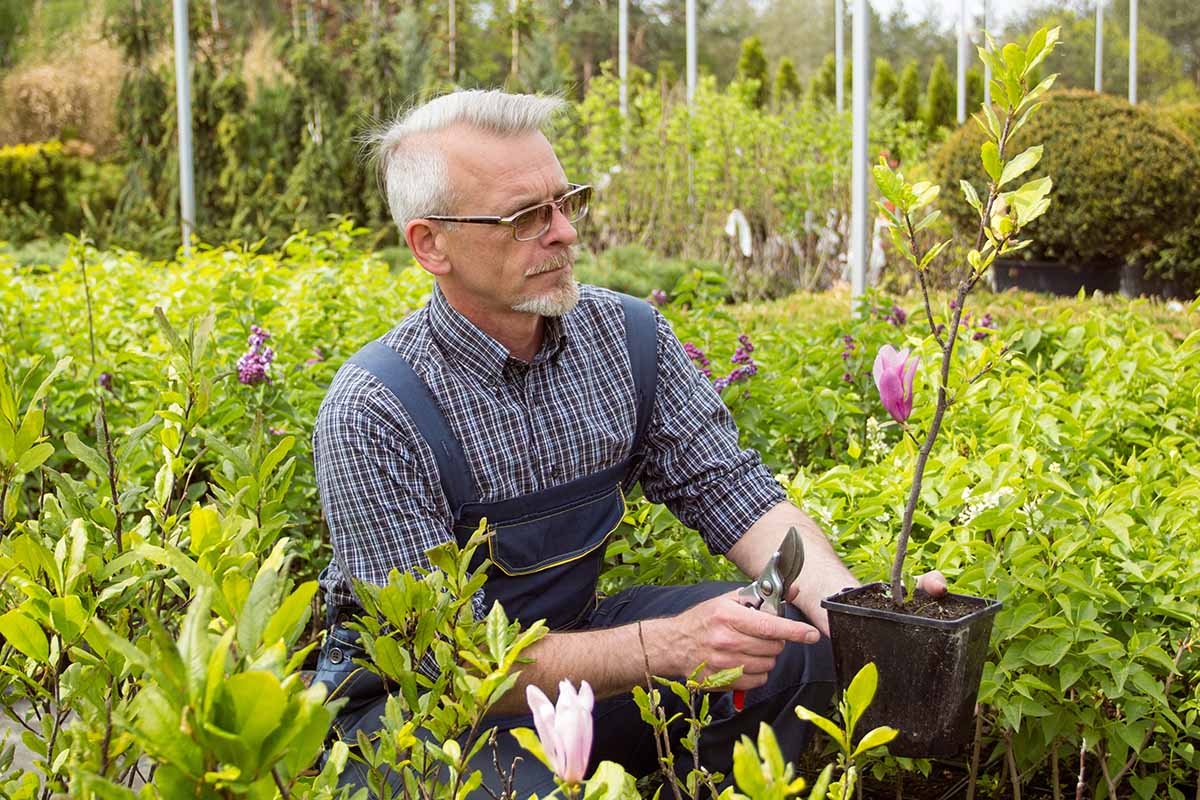
Young southern magnolias have long taproots, so be careful not to disturb or break the root. As the tree ages, the roots become more extensive with lots of lateral growth, rather than relying on the taproot.
These trees are prone to girdling, which is when the roots grow in a circle around the trunk, either at or below the soil line. This can act like a gradually tightening noose around the trunk, strangling the plant.
To help avoid this, be careful to spread out the roots when you transplant.
The roots grow extremely wide, so don’t place the magnolia too close to things like building foundations or a septic system.
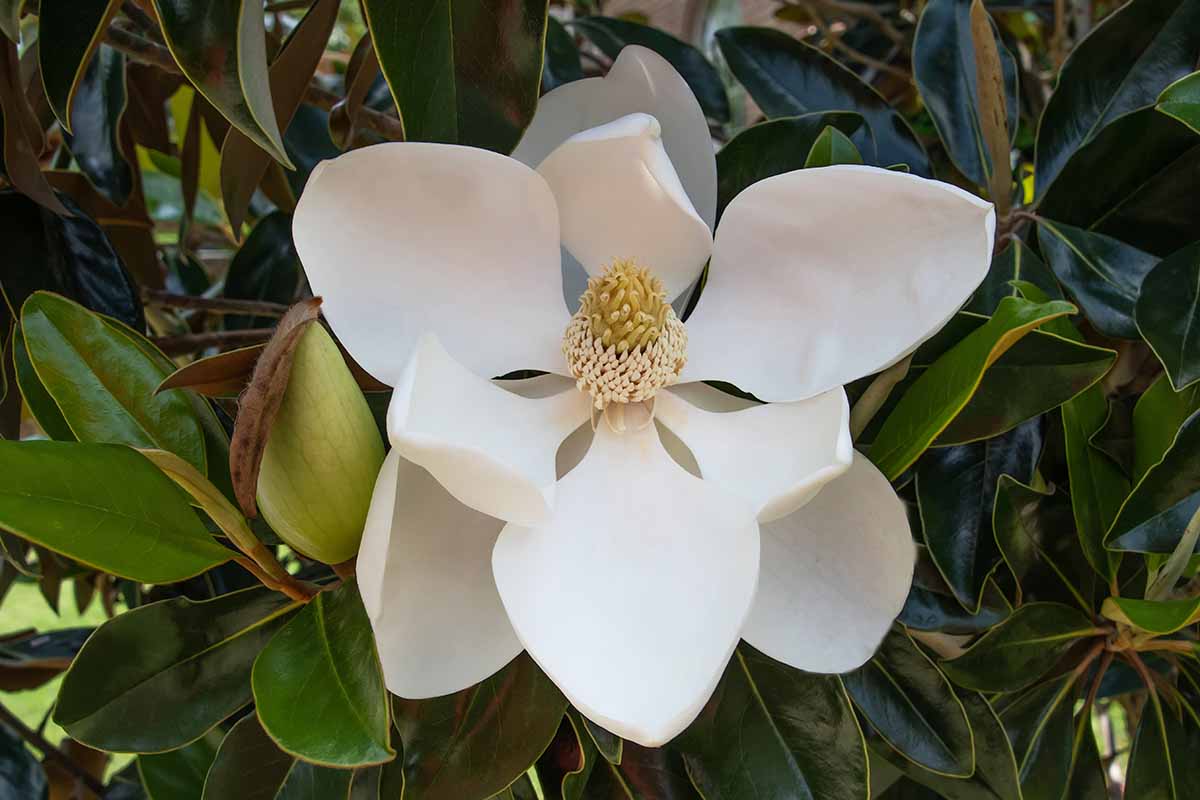
Assume that the roots will grow four times as wide as the canopy width at maturity. Plants should be 40 feet apart, not just to accommodate the roots, but because the canopy can grow that wide.
Pick your location carefully because these wide roots make it difficult to transplant the tree if you need to move it later on.
Once you’ve chosen your location, dig a hole large enough to accommodate the root system of your sapling.
Place the plant only so deep that you can see the beginning of the root flare, which should put the bottom of the trunk about two inches above the surrounding soil line.
Then, backfill with soil. Heap three inches of bark or leaf mulch over the soil, but keep it away from the trunk.
If you place the plant too deep in the soil, the roots will want to grow upwards and outwards rather than down.
For the first four years after planting, the magnolia will be establishing its root system, so keep the soil moist but not wet.
The mulch will help retain moisture and reduce weed competition. If any weeds do manage to poke through, pull them up promptly.
How to Grow Southern Magnolias
Southern magnolias thrive in full sun to partial shade. When they’re young, they can tolerate nearly full shade, but as they mature, they need brighter sun.
Luckily, they tend to take care of that themselves by growing tall enough to escape the shade cast by shorter trees and shrubs. If young specimens are grown in shadier conditions, they might mature to have a shrubbier shape.
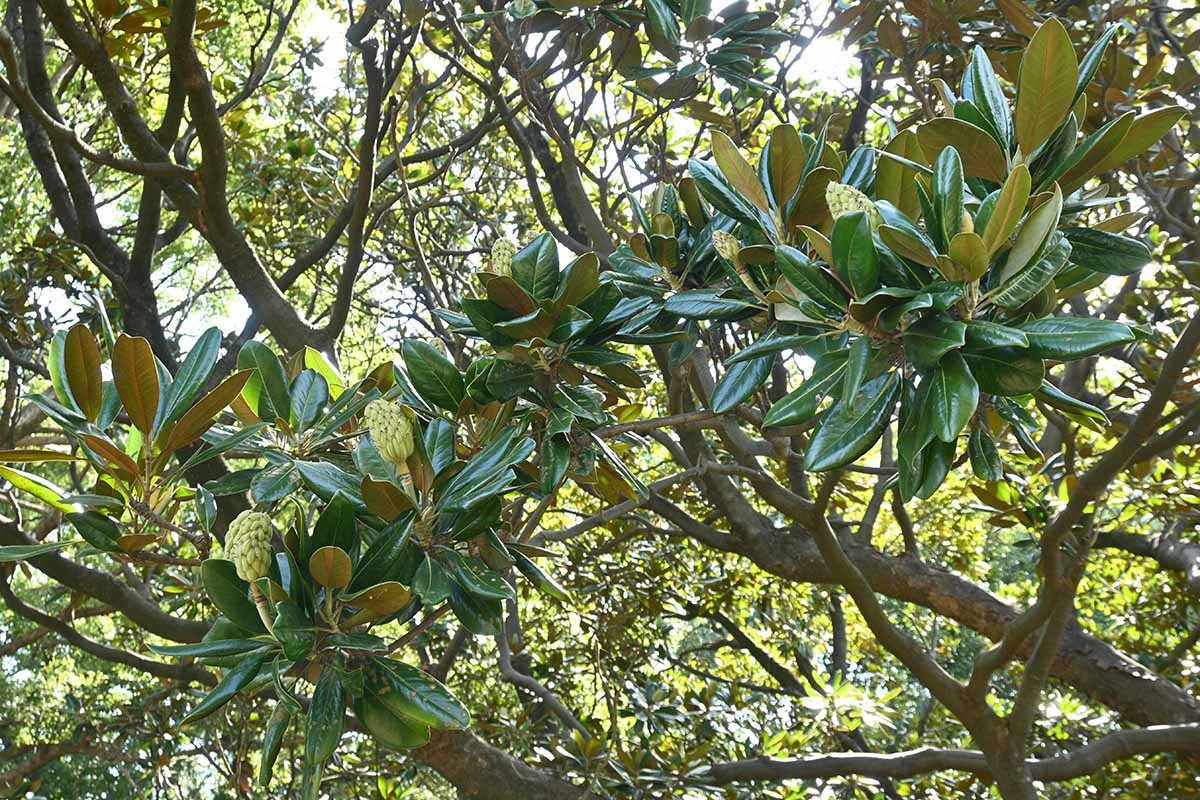
They prefer loamy, peaty soil, but a bit of clay or sand is fine, as well. The soil can be slightly alkaline, neutral, or acidic, but the ideal pH is slightly acidic, with a pH between 5.5 and 6.5.
The soil should be well-draining but able to retain moisture as southern magnolias need consistent moisture to grow best.
These trees can tolerate a bit of temporary drought, but if you live in a hot region with dry summers, it’s probably best to put your young magnolia in partial shade and heap lots of mulch on top of the roots to help the soil stay cool and retain moisture.
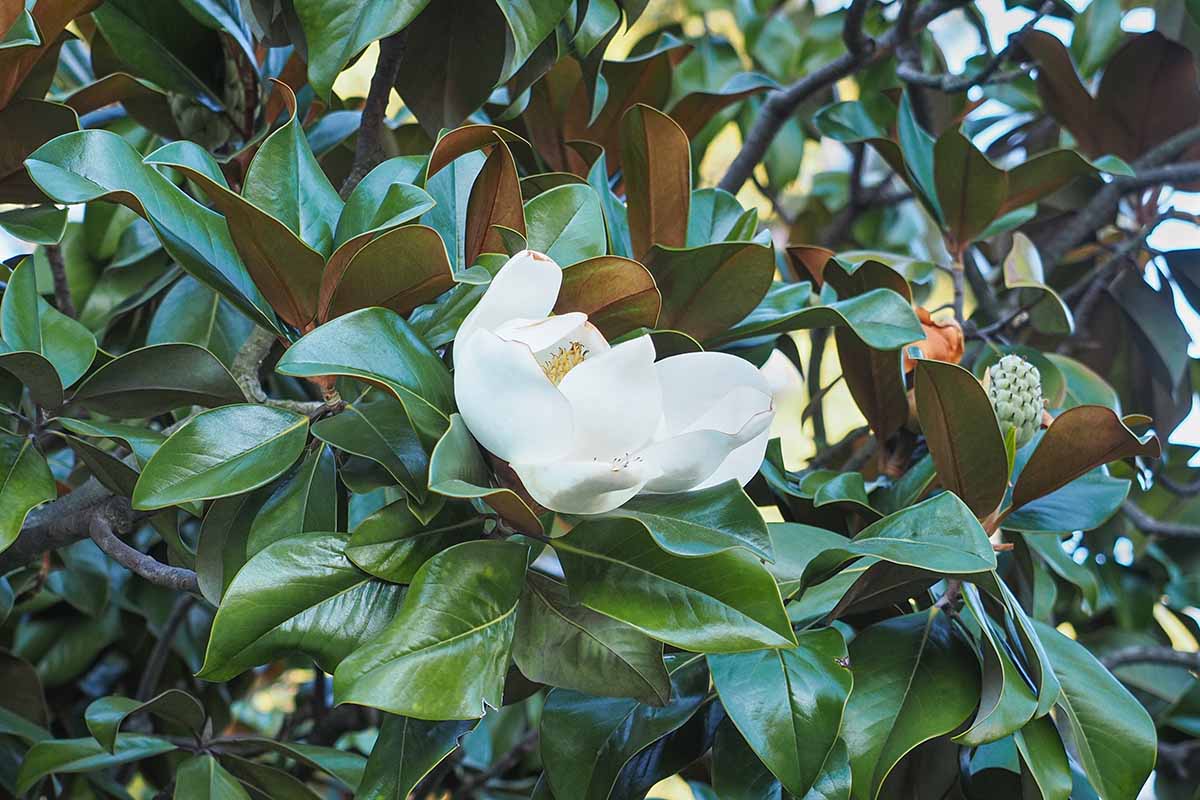
They will also tolerate temporary wet soil in the case of seasonal flooding, but don’t let it sit around too long, or it will cause root rot.
Once established, you won’t need to add any moisture unless you have an abnormally prolonged drought. The exception is if you live in a desert climate, the tree will require irrigation. The soil should be watered once it’s fully dry.
Be cautious when working around the base of the tree. The bark is thin, so if you nick it with a shovel, trimmer, or cultivator, you can make the tree vulnerable to pests and diseases.
Fertilize with an all-purpose food once a year in the spring for the first five years. After that, the tree should be able to obtain the nutrients it needs from the soil.
Down to Earth All Purpose Food
Something like Down to Earth’s All Purpose food is perfect. Pick up a pound, five pounds, or 15 pounds at Arbico Organics. Follow the manufacturer’s instructions for application.
Growing Tips
- Plant in partial to full sun.
- Apply mulch around the base to help retain moisture.
- Provide even moisture for young specimens for the first four years.
Pruning and Maintenance
The lower branches of southern magnolias tend to bend to the point where they can intrude on traffic or even touch the ground. Prune these off at the trunk.
You should also remove any branches that have a tight crotch, which means two branches are growing close together at their bases. These are weak and tend to break. Remove the smaller of the two.

Pruning is best done in late winter or very early spring before the buds start to swell. Make sure the air temperature has been above 35°F for the preceding days so avoid pruning frozen wood.
Otherwise, there isn’t any further work required. Southern magnolias are truly low-maintenance.
The biggest challenge will be leaf clean-up. Each leaf lives about two years and then it drops from the tree. Since each one can be eight inches long, it only takes a few to create a big mess.
And somehow, they can travel. My neighbor’s southern magnolia regularly sends leaves into my yard. That might not seem surprising, but this neighbor happens to be two houses away from me!
Southern Magnolia Cultivars to Select
Southern magnolias are beautiful trees, and plant breeders have developed a number of different cultivars.
If you want to grow the species tree, you can pick one up at Nature Hills Nursery.
Here’s a selection of some standout cultivars:
Bracken’s Brown Beauty
‘Bracken’s Brown Beauty’ is a mouthful to say and a marvel to grow because it can survive in climates much colder than the species or most other cultivars.
It’s tough enough to survive as far north as Zone 5, though it might drop its leaves in colder areas during the winter.
It also stays compact, growing to just 30 to 50 feet or so tall, and is widely regarded as being the fastest-growing southern magnolia out there, putting on two feet of growth per year.
It has a dense, pyramid shape with a textured appearance thanks to the large, leathery green leaves with distinctly brown undersides.
Nature Hills carries this popular tree in #2, #3, and #7 containers.
D.D. Blanchard
‘D.D. Blanchard’ has massive eight-inch blossoms, but what sets it apart from the species tree is the foliage.
The leaves are large, deep, and dark green, which is unusual for the species, with a rusty brown hue on the underside. It holds its leaves upright so you can plainly see the contrasting undersides.
The trees reach about 50 feet in height with a pyramidal, open shape and a strong central leader.
Grab yours from Nature Hills Nursery in #3 and #7 containers.
Edith Bogue
Beautiful ‘Edith Bogue’ is hardy down to Zone 5. Though the tree might drop some of its leaves in the winter, it will survive without any fuss or extra care.
The massive blossoms are the size of dinner plates at a foot in diameter, on a tree that can grow up to 60 feet tall.
It’s fairly narrow, however, reaching just 30 feet wide, so it can fit into a relatively small area.
If you’d like to invite ‘Edith Bogue’ to your garden, visit Fast Growing Trees to bring home a three- to four- or four- to five-foot-tall tree.
Goliath
Aptly named, ‘Goliath’ sports giant, 12-inch-wide flowers, that persist on the tree for a long, long time.
The tree has a dense, rounded growth habit made up of green leaves with reddish-brown undersides.
This cultivar doesn’t live up to its moniker when it comes to height, though. It’s on the smaller side, growing to about 50 feet tall. It’s quick to start flowering.
Kay Parris
A likely cross between ‘Little Gem’ and ‘Bracken’s Brown Beauty,’ the magnificent ‘Kay Parris’ was introduced by Gilbert’s Nursery in South Carolina in the early 1990s.
It was named for Katherine Killingsworth Parris, the mother of Kevin Parris at Gilbert’s Nursery.
Noted magnolia experts declared the young plant to be destined to be one of the top magnolias. This has proven to be true, and the cultivar can be found in gardens across the globe.
It also received the Royal Horticultural Society’s Award of Garden Merit.
It produces an abundance of ten-inch blossoms on a 20-foot tree that has a dense, pyramidal shape. Unlike other cultivars, it will reliably produce snow-white blossoms throughout the summer.
If you’re looking for a southern magnolia, you can’t go amiss with this one. Pick one up at Nature Hills Nursery.
Green Giant
The “giant” in ‘Green Giant’ refers to the absolutely massive leaves, which are eight inches or more in length.
They’re pure green on the top and rusty on the undersides and emerge from the tree as golden yellow.
The flowers are ten inches in diameter on a tree that grows to about 60 feet tall.
This tree isn’t for those in cooler climates. It’s only hardy in Zones 7 to10. But if you live in one of these Zones, the pyramidal shape, glossy foliage, and huge flowers are a treat.
You can pick one up at Nature Hills Nursery.
Little Gem
If the thought of a grand magnolia appeals to you, but you don’t have that much room to spare in your garden, consider ‘Little Gem.’ It’s a dwarf cultivar that only reaches up to 20 feet tall.
This little beauty was brought to us from the minds at Monrovia Nursery and has a compact, pyramidal shape that works well as a specimen, windbreak, or screen.
Because it has a narrow growth habit, you can thoughtfully grow other species around it without totally shading them out.
You can find ‘Little Gem’ available at Fast Growing Trees.
Managing Pests and Disease
Squirrels love the flower buds, and birds eat the berries, but herbivores aren’t otherwise interested in this tree. Thank goodness. You don’t have to worry about deer gnawing it down to a nub.
Insects
As mentioned, this tree is relatively resistant to pests and diseases. There are just a few insects that can be a problem.
Borers
Magnolia borers (Euzophera magnolialis), root collar borers (E. ostricolorella), and black twig borers (Xylosandrus compactus) all target magnolias, particularly trees that are stressed by drought or soggy soil.
Magnolia borers feed only on southern magnolias and are only found in the South.
The first two borers mentioned are brown moths and the black twig borer is a beetle, but it’s not the adults that you have to worry about. It’s the larvae that cause problems.
The larvae tunnel into the twigs and branches, producing cankers, frass, and round entrance or exit holes. As the tree suffers, it takes on a generally unwell appearance.
All three are opportunistic and typically attack trees that are already stressed or sick. If you cure the original problem, they will often head to greener (erm, browner?) pastures.
However, black twig borers can introduce Fusarium solani, a nasty infection which causes twig death and can even kill small trees.
Prune infested twigs and spray your tree regularly with a product containing Bacillus thuringiensis v. kurstaki (Btk) starting as soon as you notice symptoms or after the last predicted frost date. Repeat every week through the summer.
You can pick up Bonide’s Thuricide, which contains Btk, at places like Arbico Organics. They have quart or gallon ready-to-use or eight or 16-ounce concentrate.
Scale
Magnolia scale (Neolecanium cornuparvum) is a soft-scaled insect that doesn’t hang out in one spot like your typical scale species.
It’s highly mobile, crawling up and down the tree looking for the best spots to feed on the sap using their sucking mouthparts.
They’re also one of the largest types of scale insects in North America at half an inch in length. They have a protective waxy coating over their pinkish-brown bodies.
As you can imagine, given their size, a large infestation of these insects can cause serious damage. They can weaken a tree enough to kill it.
Plus the honeydew they secrete attracts sooty mold and makes an unholy mess under the tree. Woe be to anyone who parks their car under a magnolia infested with scale – I say this from experience.
The good news is that southern magnolias aren’t their preferred source. They’ll generally shoot for star (M. stellata) and cucumber magnolias (M. acuminata) first.
Natural predators should keep scale populations in check, but if you spray insecticides in your garden, it’s likely that populations of predators like lady beetles and lacewings have been reduced.
In that case, stop spraying, if you can, and introduce these beneficial insects into your garden.
Ladybugs are suffering due to their popularity for releasing into the garden and wild populations are under threat.
That’s why it’s vital that you try your best to make your garden a place where they can thrive.
That means limiting pesticide use, growing a variety of species but especially natives, and planting species that they love, like alyssum.
You can also purchase insects like lacewings to release into your garden.
In this case, you can start with the larvae or purchase adults, which Arbico Organics carries in 100, 250, 500, or 1,000 counts.
You can learn more about how to deal with scale in our guide.
Disease
If I could wave my magic wand and get rid of one plant disease, it would probably be verticillium wilt.
This disease attacks many, many species and can kill a huge, mature tree or beloved shrub that has been around for decades in just one season. Plus, there is no cure. Sadly, southern magnolias are susceptible.
Leaf scorch, heavy seeding, and branch death are all common signs. If you cut off a branch and strip the bark, you can see brown streaks or brown sapwood.
If your tree is infected, there’s nothing you can do but remove it. And, because the pathogen lives in the soil for years, you can’t plant anything there that’s susceptible to the disease for at least ten years.
Ginkgo, juniper, spruce, pine, sequoia, birch, dogwood, hawthorn, fig, mulberry, oak, and willow trees are all resistant options.
Learn more about common diseases that affect magnolias in our guide.
Best Uses for Southern Magnolias
As a shade tree, there are few rivals. The southern magnolia works in home gardens, commercial areas, and parks.
Just keep in mind that nothing but complete shade lovers will grow underneath them. Don’t plan to have a nice lawn area under your tree.
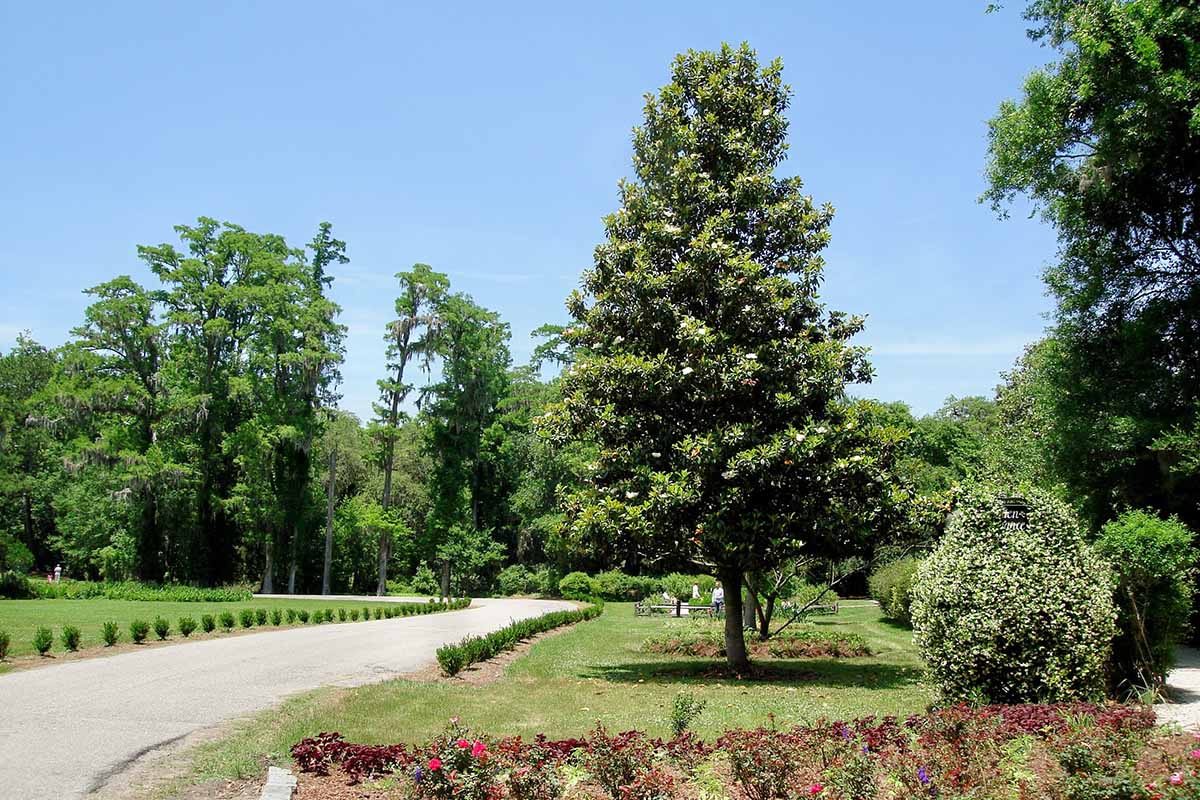
Hostas (Hosta spp.), English ivy (Hedera helix), ferns, barrenwort (Epimedium spp.), deadnettle (Lamium spp.), sweet woodruff (Galium odoratum), and vinca (Vinca major) are going to be your best friends.
The trees can be planted streetside since they tolerate pollution, though they will probably require pruning to keep those lower branches from blocking traffic or parking areas.
If you choose one of the columnar cultivars, you can use them as a screen or a windbreak.
They also work well for espalier and smaller cultivars can be grown in containers.
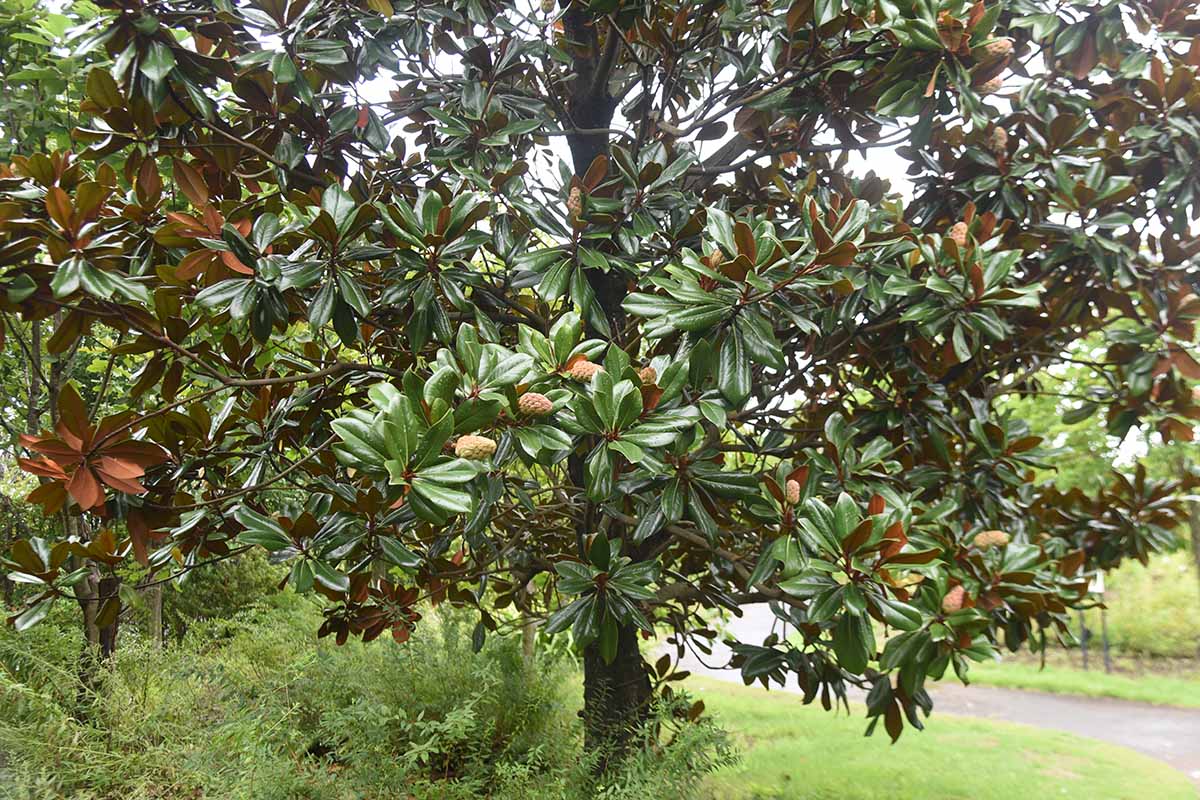
Keep in mind that the trees continually drop old leaves as new ones replace them.
That means there will be leaf litter under the tree pretty regularly. You might not want to plant yours next to a patio if you don’t like to do regular cleaning.
You can certainly cut the flowers and use them in arrangements, but don’t forget the foliage. It makes a beautiful addition to an arrangement, and it’s available all year round.
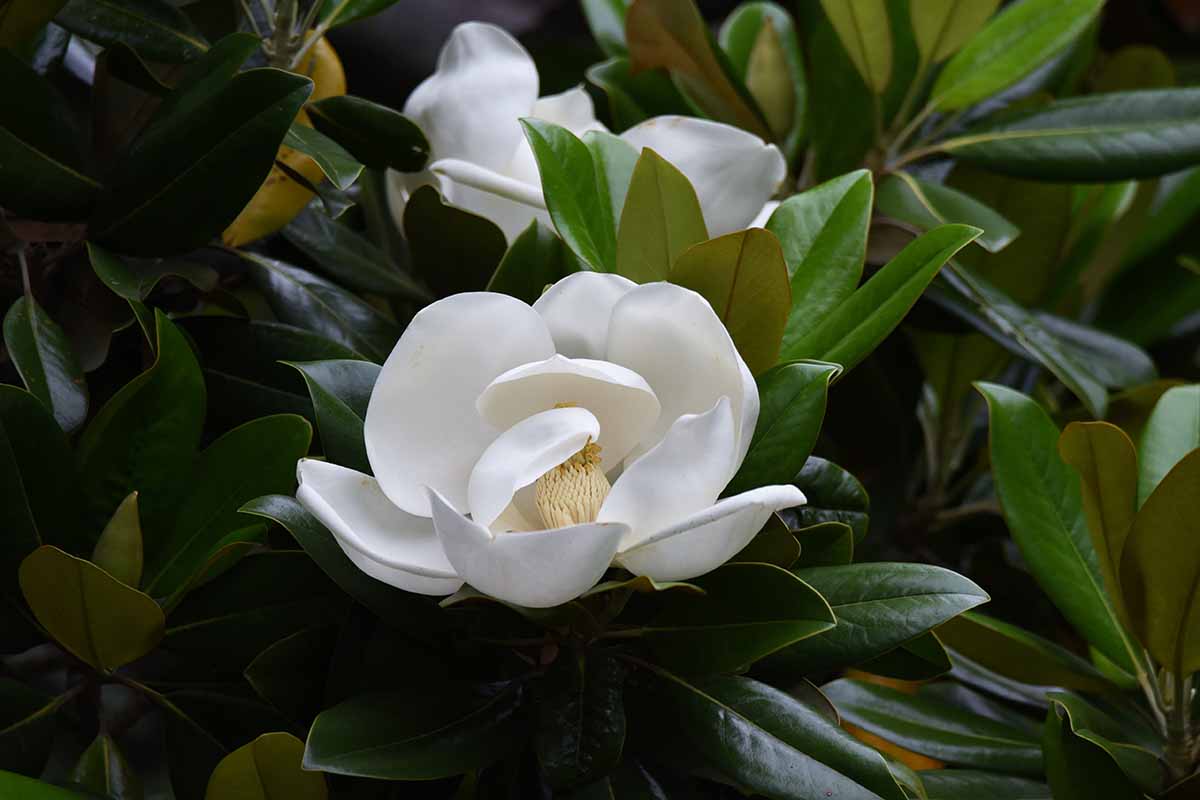
Salt doesn’t faze these trees, so coastal gardeners can enjoy their elegant performance.
They will tolerate areas with exhaust pollution so you can grow them in urban or suburban areas. Just remember, they have extensive roots and can lift sidewalks or driveways.
They also survive hurricanes relatively intact, with perhaps some branch loss, but they tend not to topple over. Thanks to their year-round, dense foliage, as a shade tree, they can help reduce the cost of cooling your home.
Quick Reference Growing Guide
| Plant Type: | Broadleaf evergreen tree | Flower/Foliage Color: | White/green, rust |
| Native to: | North America | Maintenance: | Low |
| Hardiness (USDA Zones): | 5-10 | Tolerance | Salt, pollution, drought, flooding |
| Bloom Time: | Spring, summer | Soil Type: | Loamy, loose |
| Exposure: | Partial shade to full sun | Soil pH: | 5.5-6.5 |
| Time to Maturity: | 50 years | Soil Drainage: | Well-draining |
| Spacing: | 40 feet | Attracts: | Birds, beetles |
| Planting Depth: | 2 inches above surrounding soil with root flare just visible | Companion Planting: | Barrenroot, deadnettle, ferns, hostas, ivy, sweet woodruff, vinca |
| Height: | Up to 120 feet | Uses: | Specimen, espalier, windbreak, container, screen, cut flowers, street |
| Spread: | Up to 60 feet | Order: | Magnoliales |
| Growth Rate: | Moderate | Family: | Magnoliaceae |
| Water Needs: | Moderate | Genus: | Magnolia |
| Common Pests and Diseases: | Borers, scale; Verticillium wilt | Species: | Grandiflora |
Elegant Year-Round Interest
Southern magnolias really are the trees that can do it all.
They’re obviously beautiful, but it’s hard to find a tree that combines elegance with toughness, adaptability, low care requirements, and disease resistance, that still provides year-round interest.
Where will you grow your southern magnolia? Let us know in the comments section below!
And for more information about growing magnolias in your garden, check out these guides next:
